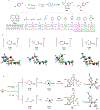Photochemical C-H Activation Enables Nickel-Catalyzed Olefin Dicarbofunctionalization
- PMID: 33660996
- PMCID: PMC8012054
- DOI: 10.1021/jacs.0c13077
Photochemical C-H Activation Enables Nickel-Catalyzed Olefin Dicarbofunctionalization
Abstract
Alkenes, ethers, and alcohols account for a significant percentage of bulk reagents available to the chemistry community. The petrochemical, pharmaceutical, and agrochemical industries each consume gigagrams of these materials as fuels and solvents each year. However, the utilization of such materials as building blocks for the construction of complex small molecules is limited by the necessity of prefunctionalization to achieve chemoselective reactivity. Herein, we report the implementation of efficient, sustainable, diaryl ketone hydrogen-atom transfer (HAT) catalysis to activate native C-H bonds for multicomponent dicarbofunctionalization of alkenes. The ability to forge new carbon-carbon bonds between reagents typically viewed as commodity solvents provides a new, more atom-economic outlook for organic synthesis. Through detailed experimental and computational investigation, the critical effect of hydrogen bonding on the reactivity of this transformation was uncovered.
Conflict of interest statement
The authors declare no competing financial interest.
Figures





References
-
- Davies HML; Morton D Recent Advances in C-H Functionalization. J. Org. Chem 2016, 81 (2), 343–350. - PubMed
-
- Wan JP; Gan L; Liu YY Transition metal-catalyzed C-H bond functionalization in multicomponent reactions: a tool toward molecular diversity. Org. Biomol. Chem 2017, 15 (43), 9031–9043. - PubMed
-
- Derosa J; Tran VT; Boulous MN; Chen JS; Engle KM Nickel-Catalyzed beta,gamma-Dicarbofunctionalization of Alkenyl Carbonyl Compounds via Conjunctive Cross-Coupling. J. Am. Chem. Soc 2017, 139 (31), 10657–10660. - PubMed
Publication types
MeSH terms
Substances
Grants and funding
LinkOut - more resources
Full Text Sources
Other Literature Sources

